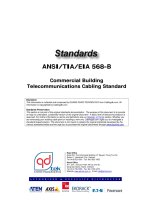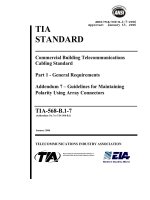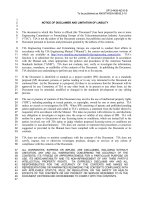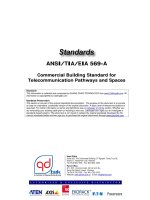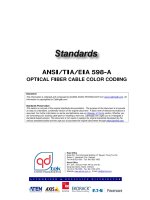Tài liệu Cabling Standard - TIA 758 - Customer Owned Outside Plant pptx
Bạn đang xem bản rút gọn của tài liệu. Xem và tải ngay bản đầy đủ của tài liệu tại đây (219.7 KB, 35 trang )
A
A
N
N
S
S
I
I
/
/
T
T
I
I
A
A
/
/
E
E
I
I
A
A
7
7
5
5
8
8
Customer Owned Outside Plant
Disclaimer
This information is collected and composed by QUANG DUNG TECHNOLOGY from www.Cablingdb.com. All
information is copyrighted by Cablingdb.com.
Standards Preservation
This section is not part of the original standards documentation. The purpose of this document is to provide
an easy to understand, condensed version of the original document. A basic level of telecommunications is
assumed. For further information on terms and definitions see our Glossary of Terms section. Whether you
are renovating your existing cable plant or installing a new one, Cablingdb.com urges you to investigate a
standards based solution. This document is not meant to replace the original standards developed by the
various standards bodies and we urge you to purchase the original documents through www.tiaonline.com.
AUTHORIZED & EXCLUSIVE DISTRIBUTOR
Head Office
Suite 202, The Colonnade Building, 27 Nguyen Trung Truc St.,
District 1, Hochiminh City, Vietnam
Tel: 84.8 823-1693 Fax: 84.8 823-1665
Hanoi Office
A11, 3/Fl., Horizon Hotel, 40 Cat Linh St.,
Dong Da District, Hanoi, Vietnam
Tel: 84.4 736-7055 Fax: 84.4 733-2470
Website: www.qd-tek.com.vn
Email:
ANSI/TIA/EIA 758
Telecommunication Cabling of Customer Owned Outside Plant
Quang Dung Technology Distribution Company Page 2 of 35
Table of Contents
Cabling Infrastructure
Introduction
Building Entrance Terminals
Cabling
Connecting Hardware
Copper Splicing
Fiber Splicing
Pressurization of Air Core Cables
Pathways and Spaces
Introduction
Aerial
Bridge Crossings
Conduit
Direct Buried
Handholes
Maintenance Holes
Pedestals/Cabinets/Vaults
Utility Tunnels
ANSI/TIA/EIA 758
Telecommunication Cabling of Customer Owned Outside Plant
Quang Dung Technology Distribution Company Page 3 of 35
CABLING INFRASTRUCTURE
General
Outside Plant Definition
Outside plant is defined as those communications pathways, spaces and media which
are located outside of the building walls. This includes, but is not limited to the cable
(copper and fiber), splices, conduit, manholes, handholes, poles and hardware related
to the attachment and support of the various forms of media.
Function
The function of customer-owned OSP cabling infrastructure is to provide connections
between building entrance facilities, structures in a campus environment, or
telecommunications pedestals or cabinets. Customer-owned OSP cabling consists of
the backbone cables, splices, terminations, and patch cords or jumpers used for
backbone-to-backbone connection. The customer-owned OSP cabling infrastructure
shall meet the requirements of the local authority(s) and local codes.
History
Prior to the divestiture of the Bell Companies, they were the ones who looked after
the OSP infrastructure. Now, owners have a choice of who owns, installs and manages
the infrastructure. One of the main issues is the lack of standardization in
requirements and installation methods. It is now up to the owner to take on the
burden of the decision making process of what products to use and who to get to
install them.
Regardless of any of the above issues, the designer has to be aware of:
• Pathways and spaces
• Cabling
• Hardware Bonding and grounding
• Rights of way
• System documentation
Safety
The designer and installer must also be aware of the safety issues involved in working
in an OSP environment. Depending on the route the installer may be working at the
top of an aerial truck, or in a manhole or trench. It is everyone's responsibility to
ensure that proper safety precautions are taken. If the route cannot be constructed
without compromising the safety of those involved, the route should be altered.
Topology
The recommended topology for customer-owned OSP cabling is a star configuration.
This is the same type of star topology that is recommended for a local area network.
In the case where a star topology cannot be used, consider a hierarchical star. By
implementing a star, or hierarchical star the system can be managed and maintained
easier than other topologies. The same advantages of a LAN star topology can be
found in a campus star topology.
ANSI/TIA/EIA 758
Telecommunication Cabling of Customer Owned Outside Plant
Quang Dung Technology Distribution Company Page 4 of 35
In a star topology one of the buildings will act as the MC and feed out the backbone
cables to the various buildings. In a hierarchical star there may be a building acting as
an MC, and the another group of buildings is served by a building acting as an IC.
Other types of topologies that may be used are a bus or tree and branch topology,
physical wired star/virtual ring and a ring. A ring topology may be a single path ring,
a counter rotating redundant ring or several attached rings.
Each type has its disadvantages and advantages depending on the layout of the
network, media chosen and applications being run, and as well, the overall goal of the
network.
Recognized Cables
An OSP environment may support several applications such as CATV, LAN, WAN, and
voice over a variety of distances and in a number of different physical and
environmental settings. For these reasons OSP cable must be able to support all of
these environments and applications. Therefore several cables are recognized by the
standards. The recognized media include:
• 50/125µm optical fiber cable
• 62.5/125µm optical fiber cable
• singlemode optical fiber cable
• 100 ohm twisted-pair cable
• 75 ohm coaxial cable
A single media may not satisfy all of the requirements of the owner, and therefore
several types of media may be required. When possible the various media should use
the same pathways to keep administration and costs down. In making this choice,
factors to be considered include:
• flexibility with respect to supported services
• required useful life of backbone cabling
• site size and user population
Bonding and Grounding
Bonding and grounding shall meet the appropriate requirements and practices of
applicable authorities and codes. Additionally, grounding and bonding within buildings
shall conform to ANSI/TIA/EIA-607 requirements, and the National Electrical Safety
Code (NESC) between buildings. Failure to follow these standards and codes can
result in interference, improper operation and possible harm to those operating the
system.
ANSI/TIA/EIA 758
Telecommunication Cabling of Customer Owned Outside Plant
Quang Dung Technology Distribution Company Page 5 of 35
BUILDING ENTRANCE TERMINALS
General
This portion of the standard covers the requirements for building entrance terminals
located at the cabling entrance to building facilities where the transition between
inside and outside environments occur. Building entrance terminals can be used on
the outside of the building or on the inside, with the inside being the primary choice.
Building entrance terminals are available in sizes such as 2-pair, 4-pair, 6-pair, and
multiples of 10- and 25-pair. It is desirable that terminal blocks for be of the IDC
type, such as 110.
Terminal Protection
Protected terminals
Protected terminals shall meet the primary protection requirements of UL 497 and the
mechanical and reliability requirements of this Standard.
CABLING
Twisted Pair Cable
General
This section covers the requirements for multi-pair customer-owned OSP twisted-pair
cables that are used in campus environments. Coaxial cable and fiber optic cable are
covered later in the section. OSP cables are intended for the distribution of
communications signals which carry voice and data. Enhanced performance, referred
to as Broad Band Outside Plant (BBOSP) cables are intended for the distribution of
signals to carry voice, high-speed data, and video. Cables used shall:
• meet the requirements of the AHJ and applicable codes
• consist of 19 AWG, 22 AWG, 24 AWG, or 26 AWG thermoplastic
insulated solid copper conductors in one of the designs listed below.
Cable Construction Types
OSP and BBOSP cabling is installed in aerial, duct (underground), and direct-buried
applications. A filled cable may be used in all applications, whereas an aircore cable is
not recommended for direct buried use.
Aerial (self-support and lashed)
Aerial cables come in two major classifications, self supporting and non self
supporting. Self-supporting cable has a steel support messenger designed into the
cable. This type of cable is more sometimes referred to as "Figure 8" cable because its
cross sectional view looks like an "8". OSP cable intended for aerial use without a
support messenger shall be lashed to a support messenger.
Direct Buried Cable
ANSI/TIA/EIA 758
Telecommunication Cabling of Customer Owned Outside Plant
Quang Dung Technology Distribution Company Page 6 of 35
Direct buried cables are placed directly into the ground through a variety of methods
such as vibratory plough or trenching. These cables shall have a moisture barrier
compound within the cable to prevent moisture from entering the cable should the
outer sheath be penetrated.
Underground Cable
Underground cables are placed in a duct system rather that directly into the ground.
This helps prevent against rodent and environmental damage. Cables placed in a duct
system may, or may not contain a moisture barrier compound.
Buried Service Wire
Buried service wire is intended for use when extending from the distribution cable to
the entrance facility of a building.
Aerial service wire
Aerial service wire is used when extending from the distribution cable terminal to the
entrance facility of a building. The maximum span length shall not exceed 60 m (200
ft).
Screened Cable (internally)
Internally screened OSP cable is for use with pulse code modulation (PCM)
transmission. The screens separate cable pairs within the core into compartments
(i.e., one containing the transmit pairs, and the other the receive pairs) for improved
crosstalk performance over regular OSP cable.
Cable Performance
Cable Type
Performance Specification
Filled OSP
ANSI/ICEA S-84-608
Air Core OSP
ANSI/ICEA S-85-625
Broadband Filled OSP (BBOSP)
ANSI/ICEA S-99-689
Broadband Air Core OSP
ANSI/ICEA S-98-688
Filled Screened Cable
ANSI/ICEA S-84-608
Air Core Screened Cable
ANSI/ICEA S-85-625
Buried Service Wire*
ANSI/ICEA S-86-634**
Aerial Service Wire*
ANSI/ICEA S-89-648**
Notes
* The performance requirements of the cable should be verified to ensure
they meet the overall design criteria.
** The maximum length of the cable shall not be more than 213 m (700ft)
75 Ohm Coaxial Cabling
General
Coaxial cable used in backbone OSP applications is 75 ohm semi-rigid cable referred
to as trunk, feeder and distribution coaxial cable. The cable is available in sizes
ranging from 10 mm to 29 mm (0.412 in to 1.160 in) in diameter. In designing a coax
system, the designer must understand the relationship between attenuation and the
ANSI/TIA/EIA 758
Telecommunication Cabling of Customer Owned Outside Plant
Quang Dung Technology Distribution Company Page 7 of 35
diameter of the cable. Since attenuation is lower with a larger diameter cable, the
cable choice will affect the number of amplifiers in the system.
Cable Performance
Performance, mechanical and electrical requirements of coaxial cable are goverened
by the Society of Cable Television Engineers (SCTE). This group is somewhat equal to
ANSI/TIA/EIA in that they specify the criteria for proper installation, testing and
performance of coaxial systems and products.
Mechanical and electrical requirements for 75 ohm trunk, feeder and distribution
coaxial cable are found in the Society of Cable Television Engineers (SCTE) document
IPS-SP-100.
Connecting Hardware
Connecting hardware used with OSP Coaxial Cable is referred to as "N" type
connecting hardware, and it is designed to fit each particular cable size and type.
Connecting hardware includes connectors, taps and splitters. The designer should
verify with the cable manufacturer regarding connecting hardware that is compatible
with their cable.
Installation Requirements
The SCTE document "Recommended Practices for Coaxial Cable Construction and
Testing, Issue 1, Section 1" provides the necessary information required for proper
installation practices.
Testing
The minimum test requirements for 75 Ohm coaxial cable shall include a continuity
test for the center conductor and shield. The installer may test the following
parameters;
• Attenuation
• Length
• Characteristic impedance
• Return loss
• DC loop resistance
Optical Fiber Cabling
General
This section details the requirements of fiber optic cables as they apply to an OSP
system. Although connecting hardware
and splices may be part of this system, they
are described in more detail in their respective sections.
The designer should take into consideration the following:
• bandwidth requirements of the system (short and long term)
• system length
• system capacity
• route redundancy
Recognized Cables
ANSI/TIA/EIA 758
Telecommunication Cabling of Customer Owned Outside Plant
Quang Dung Technology Distribution Company Page 8 of 35
Both multimode fibers and singlemode fibers or a combination of these fiber types are
acceptable. When both types of optical fibers are combined, some means of
segregating the fibers by type shall be used.
Cable Performance
OSP optical fiber cable shall meet the performance requirements of ANSI/ICEA S-83-
640 and ANSI/TIA/EIA-568-B.3.
Cable Construction Types
OSP optical fiber cable shall meet the physical requirements of ANSI/ICEA S-83-640.
Optical fiber cables come in several designs with many construction options.
Duct Cables
Duct cables are generally non-armored cables. All-dielectric versions (no metallic
components), which incorporate a nonmetallic central member, are available and are
suitable for duct, aerial or conduit placement.
Armored Cables
Armored cables have a steel armor layer added under the outer cable jacket. The
armor is added to improve the rodent resistance capability of a direct-buried cable,
and also provides an extra layer of protection against other factors, such as rocky
soil.
Aerial Cables
Aerial cables typically have the same cable construction as duct cables and com in two
versions, self supporting and Figure 8.
All-dielectric optical cables are recommended when practical since these cables are
not as susceptible to lightning strikes, are not subject to induced voltages and are not
required to be grounded as are cables with metallic components.
Self-Supporting Cables
These cables are designed to be installed without the need for a pre-installed
messenger (Figure 8). These cables may or may not have metallic components in
them. An All Dielectric cable contains NO metallic components. Self supporting cables
require no lashing and may therefore be easier to install than a Figure 8 cable or a
lashed cable.
There may be load, length and span length limitations on these cables depending on
wind and ice conditions in the geographic area the cable is being installed in. The
designer should check for any special hardware required.
Figure 8 Cables
As with copper, these self-supporting cables incorporate a metallic messenger in a
common sheath.
Indoor/Outdoor Cables
ANSI/TIA/EIA 758
Telecommunication Cabling of Customer Owned Outside Plant
Quang Dung Technology Distribution Company Page 9 of 35
Some cables can be installed in both outdoor and indoor locations. This type of cable
combines the attributes of an outdoor cable, ie: water blocking and UV resistance, as
well as a flame resistant jacket (riser rated)suitable for indoor applications. This
avoids transitioning to an indoor fiber, thereby reducing costs and system losses due
to splicing and/or connectorization. However, the designer should be aware that the
cost of this type of fiber is higher than regular outdoor fiber, and that there is a cost
point where using the two individual fiber types is more advantageous.
Drop Cables
Drop cables are typically small diameter, low fiber count cables with limited
unsupported span distances. They are used to feed a small number of fibers from a
higher fiber count cable into a single location.
CONNECTING HARDWARE
OSP Twisted-Pair Connecting Hardware
General
The connecting hardware includes terminal blocks that are used for transition from
distribution cable to service wire, and cross-connect blocks that are used for cross-
connection between feeder and distribution cables.
Environmental Compatibility
Connecting hardware shall:
• function for continuous use within the temperature range of -40°C to 70°C (-
40°F to 158°F)
• allow for connecting and removing wires from -18°C to 50°C (0°F to 122°F)
• have terminals that are resistant to corrosion from moisture, atmosphere, UV
degradation, insecticides and herbicides.
Materials
Metal components shall:
• be resistant to or protected against general corrosion, stress corrosion cracking
and pitting.
• not produce significant galvanic corrosion effects on other metals in pedestal
terminal closures or aerial cable terminals.
Plastic parts shall:
• be resistant to fungi, heat, solvents, and stress cracking agents
• be compatible with metals and other materials used in the manufacture of
cable
• non-corrosive to metals
• resist deterioration when exposed to chemical pollutants and UV radiation.
Transmission
ANSI/TIA/EIA 758
Telecommunication Cabling of Customer Owned Outside Plant
Quang Dung Technology Distribution Company Page 10 of 35
The transmission requirements of connecting hardware used in the OSP shall comply
with connecting hardware requirements of ANSI/TIA/EIA 568-B.2. It should be noted
here that ANSI/TIA/EIA-B generally applies to the intra building components.
However, these components are the same ones used to terminate and splice OSP
cable. The testing performed on OSP cable is not subject to the same testing for the
permanent link or channel tests of the intra building cable, unless the OSP cable is a
category rated cable which is part of the loop being tested. An example may be a
school having a portable classroom located within the 100 meter channel limitation
that uses a category rated OSP cable to go from the main building to the portable.
Terminal Block Requirements
General
Terminal blocks provide a means to connect service wire to distribution cable.
Terminals are provided with a means for connecting each terminal pair to the
distribution cable, and a means for connecting the service wire to the terminal block.
OSP terminal blocks should be the insulation displacement contact (IDC) type, the
most common being 110, just like the 110 block found in voice and data
communications. Terminal blocks may be stubbed to provide conductors between the
terminal block and connection point to the cable. They are typically housed in an
enclosure designed to protect the terminal block from moisture and sun exposure.
The following requirements apply to connecting hardware used as terminal blocks in
OSP.
Wire Compatibility, Pair Identification and Mounting
Terminal blocks shall:
• be compatible with the service wire used for an application.
• have the recommended wire gauges for each block indicated by the
manufacturer
• shall meet electrical requirements for the smallest designated gauge conductor
after connecting and disconnecting the largest designated gauge conductor
• provide a means for identifying individual terminal pairs
• provide a means for identifying the polarity of tip and ring of each pair
• allow for fastening to a wood, steel or plastic backboard
Test Points
Terminal blocks shall allow access to test points for each pair without disconnecting
the service wire from the terminal or puncturing the wire insulation.
NOTE - High impedance probes are needed to use the test access points for live
high frequency applications.
Stub cable
The stub cable shall use standard color coding to indicate individual pairs and tip and
ring.
Cross-Connect Block Requirements
General
Cross-connect blocks are used in OSP to connect feeder pair to distribution pair. Cross
connect blocks may be located in cabinets, on walls or possibly even a rack designed
ANSI/TIA/EIA 758
Telecommunication Cabling of Customer Owned Outside Plant
Quang Dung Technology Distribution Company Page 11 of 35
for high density applications. In a cross connect scenario the incoming feeder lines
pairs are each terminated on a feeder cross connect block, following the appropriate
color codes. The distribution cable for the building is also terminated on a distribution
cross connect block following the proper color codes. These two blocks are then
connected, pair by pair using cross connect or jumper wire.
cross-connect blocks for OSP cable pairs should be the IDC type, the most common
being the 110 style. Cross-connect blocks are typically available in multiples of 10- or
25-pair.
Cross-connect blocks in the outside environment are subject to:
• temperature and humidity extremes
• industrial or coastal atmospheres
• applied chemicals such as insecticides, herbicides, cleaners, and other
solvents.
Wire Compatibility, Identification and Termination
Cross-connect blocks shall:
• be compatible with the feeder cable, distribution cable, and jumper wire used
• have the recommended cable and wire gauges for each block indicated by the
manufacturer
• meet electrical requirements for the smallest designated gauge conductor after
connecting and disconnecting the largest designated gauge conductor
• locate tip on the left and ring on the right for horizontal spacing, or tip above
the ring terminal for vertical spacing
• provide a means for identifying individual terminal pairs either on the block or
an adjacent surface
• have removable red markers available for attachment to a pair termination to
designate special circuits
• have markers withstand all environmental exposure required for the block
without becoming unserviceable
• be designed to eliminate the possibility of electrical shorts between any two
terminals during jumper wire placement
Test Points
All terminals shall allow access to test points for each pair without disconnecting the
jumper wire from the terminal or puncturing the wire insulation.
Terminal Density
Terminals shall be arranged to allow for a neat and compact installation, and allow for
proper jumper terminations.
Wiring Harness
When a wiring harness is used to connect the cross-connect block to the distribution
cable, the cable shall use standard color coding to indicate individual pairs and to
indicate tip and ring polarity.
Optical Fiber Connectors
ANSI/TIA/EIA 758
Telecommunication Cabling of Customer Owned Outside Plant
Quang Dung Technology Distribution Company Page 12 of 35
Optical fiber connectors shall meet the requirements of ANSI/TIA/EIA-568-B.3. The
two most often used connectors are the SC or 568SC duplex, or the ST connector.
The SC is recognized for all new installations, and the ST is grandfathered for existing
applications. Most fiber optic connectors are located within a building or
environmentally controlled structure.
Optical Fiber Patch Cords and Cross-Connect Jumpers
In environmentally conditioned spaces, patch cords and jumpers shall meet the
requirements of ANSI/TIA/EIA-568-B.3. Additionally, if the devices are located in an
environmentally unconditioned OSP spaces, patch cords and jumpers shall meet
environmental test requirements of Bellcore GR-326.
Optical Fiber Cable Installation Requirements
The location and protection of the optical fiber cable shall comply with ANSI/TIA/EIA-
590-A. All metallic components of the cable, except for metallic transmission media,
shall be bonded to each other and to ground.
The minimum bend radius for OSP optical fiber cable during installation shall not be
less than 20 times the cable diameter, and after installation shall not be less than 15
times the cable diameter.
Optical Fiber Cable Testing
Testing of OSP optical fiber cabling shall be conducted according to ANSI/TIA/EIA-
568-B.1.11.
SPLICING
Overview
Splicing can be defined as the joining of two conductors or fibers together to restore
the conductor continuity between two points. Since most cables are constructed of
more than one or two conductors or fibers, splicing generally involves more than one
or two pairs, and generally involves restoring the integrity of the cable sheath, armor
and shield.
Splicing begins with the joining of the conductors with a single splice. In copper
splicing one of the types of splices used is the 3M Scotchlok. Once all of the
conductors have been spliced they will be inserted into the splice enclosure which is
selected by the location of the splice enclosure. In a fiber optic splice, the fibers are
joined by a mechanical or fusion splice and then inserted into a splice tray.
For the purpose of this Standard, the term splice closure shall include bonding
hardware, sealing materials and the closure housing.
COPPER SPLICING
General
Copper splice connectors:
ANSI/TIA/EIA 758
Telecommunication Cabling of Customer Owned Outside Plant
Quang Dung Technology Distribution Company Page 13 of 35
• generally use IDC technology
• can be single wire connectors (discrete), or modular to splice up to 25 pairs
• can be used with 26 through 19 AWG wire
• shall be moisture resistant in OSP environments
Splicing connectors for OSP:
• have low connection resistance
• have high insulation resistance
• are robust
• resistant to moisture and corrosion
• are easy to installation
Due to the variety of connectors, manufacturers shall provide all of the necessary
tooling required to terminate their connectors.
Materials
Metal components shall:
• resist corrosion, cracking and pitting
• not produce significant galvanic corrosion effects on other metals likely to be
present in their use environment
Insulating materials:
• shall be resistant to fungi, heat, and cable cleaning solvents.
• must be compatible with metals and other materials such as conductor
insulation and filling compounds used in the manufacture of cable.
Plastic materials shall:
• be non-corrosive to metals
• resist deterioration when exposed to chemical pollutants and sunlight.
Connector filling compounds shall:
• be compatible with other connector and cable materials
• be resistant to fungi
• conform to safety and toxicology requirements at the time of manufacture.
Transmission Performance Markings
If the manufacturer so desires it may mark its splicing hardware with its level of
transmission performance and these markings shall be visible during installation. It is
suggested that the markings consist of:
· "Cat 3" for category 3 components
· "Cat 4" for category 4 components
· "Cat 5" for category 5 components
Tensile Strength
The tensile strength of a splice is the force required to pull the wire in the opposite
direction of entry to the splice. The pull out strength is expressed as a percentage of
ANSI/TIA/EIA 758
Telecommunication Cabling of Customer Owned Outside Plant
Quang Dung Technology Distribution Company Page 14 of 35
the strength required to break an unspliced wire. The minimum breaking strength for
a 19 AWG wire is 60% of 19 AWG wire breaking strength. The breaking strength for
smaller gauge splices is 75% of the wire breaking strength.
Insulation Resistance
Splicing connectors that are to be used in severe service conditions shall be tested for
moisture resistance. This test involves immersing the moisture filled or resistant
connector tap water for a period of one week. The insulation resistance shall then be
measured between each conductor and the water bath with 250 Vdc applied. No more
than 10 percent of the conductors shall be less than 10
6
ohms, not more than 25
percent shall be less than 10
8
ohms, and the remainder shall be greater than 10
9
ohms. After drying, the test units shall be restored to greater than 10
9
ohms. Those
that fall below 10
8
ohms shall be inspected for corrosion. If there is evidence of
corrosion, the unit shall be deemed to have failed the test. It should be noted that
this is a criteria for the manufacturer to follow and not the installation contractor.
Salt Fog Exposure
Terminated (or spliced) filled samples shall be exposed to salt fog per ASTM B 117 for
a period of 48 hours. The resistance though each splice shall not increase by more
than 2 milli-ohms as a result of this exposure.
OSP Twisted-Pair Cross-Connect Jumpers
Cross-connect jumper wire shall be wire of the same or higher transmission category
as the cross-connect block so as to maintain the overall performance of the system.
The twist shall be maintained to within 13 mm (0.5 in) of the entry into the cross-
connect block.
INSTALLATION REQUIREMENTS
Cable Splices for BBOSP
There are two type of splices, the butt splice (preferred) and the inline splice. An in-
line splice method can also be used if the conductors are spaced close together, i.e.,
no open loops. The amount of untwisting of the conductor pairs shall be kept at 13
mm (0.5 in) maximum. Pair splices should be staggered within the splice closure to
help maximize performance.
Bridge-Taps
Bridge taps may be used for low-frequency analog circuits, but are not recommended
for OSP circuits or high frequency digital circuits.
Binder group integrity
25-pair binder groups should not be split between termination points.
Cable Bend Radius
Cable Type
Minimum Bend Radius
During Installation
Minimum Bending Radius
After Installation
Non Gopher Resistant
10
8
Gopher Resistant
15
10
